Greater sandhill cranes overhead
It’s six in the morning; the Southwest sky is rich in hues of yellow and red, yet despite the warm colors the air is cold and brisk enough that my toes have begun to go numb. We have been waiting nearly a half-hour for the light and warmth of morning to wake-up thousands of cranes and tens of thousands of snow geese. But so far, despite the glimmer growing across the sky, there isn’t a bird in sight.
Every winter cranes and snow geese migrate from Montana, Idaho, Canada, and Alaska to Bosque del Apache, a National Wildlife Refuge in Central New Mexico. For the past twenty-one years the refuge has celebrated the bird migration with a Festival of the Cranes. People travel from around the state (and country) to see the Southwest skies fill with birds. The festival lasts a week and includes educational stands, social gatherings, tours, hikes, and speakers on natural history and the environment. For this one week the small town of Socorro becomes overrun with birders, scientists, and tourists. The name of the refuge, Bosque del Apache, translates to ‘Woods of the Apache’: the Apaches used to camp here, under cottonwood trees near freshwater.
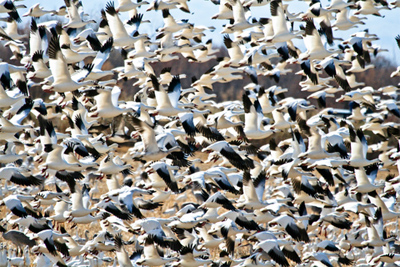 Thousands of snow geese. Photo by Thomas Christie |
The refuge was designated in 1939, however by that time the natural wetlands had shrunk to almost nothing. Damming of the Rio Grande in preceding decades dried up the wetlands and forced wildlife to seek suitable habitat elsewhere. Before the dams the Bosque del Apache flooded regularly creating marshlands along the riverbank. The situation had grown so dire that by 1941 the refuge saw a total of seventeen cranes; today it sees around seventeen thousand.
To resurrect the wetlands, park staff built canals and water systems that mimicked the natural processes of the Rio Grande before it was dammed, creating fields where native plants and animals flourish. The refuge also serves local agriculture. Today, local farmers grow alfalfa and corn on the refuge; the farmers harvest the alfalfa and leave the corn for the many bird species. Cottonwoods, once prevalent along the river and its watersheds, are now being planted again and carefully tended. The refuge is an excellent example of how devoted work and sound science can transform degraded landscape to a close approximation of its original state, serving both wildlife and humans.
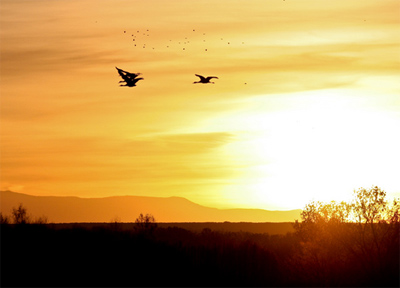 Sandhill cranes take to the sky as the sun rises. 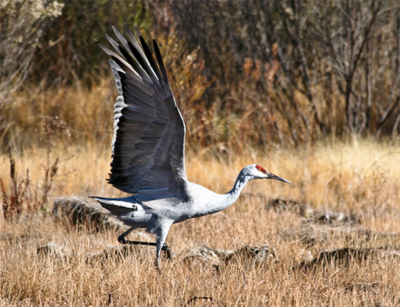 Sandhill crane readying for takeoff. Photos by Thomas Christie |
And here I was, over fifty years later, waiting for the birds that had comes close to vanishing from the region. To keep my mind off the cold, I searched the canals and marshes: I must say, one of the strangest—and most pleasant—things about visiting Bosque del Apache is seeing water, standing water, in a state rightly known for its deserts and arid mountains. Steam began to rise from the water; the earth began to warm, just in time: my toes and face were frozen.
And then it happened: the snow geese came first. The honking of thousands of birds reverberated across the refuge, the din rose, and then suddenly the entire scene from one end of the refuge to another was blurred with white feathers. I have been fortunate enough to watch wildlife in Kenya, Peru, Guyana, and Suriname, yet have never seen a flock to compare to this. In fact, the snow goose is notable for being one of the few species whose population has actually rose over the past few decades, their numbers tripling since the 1970s.
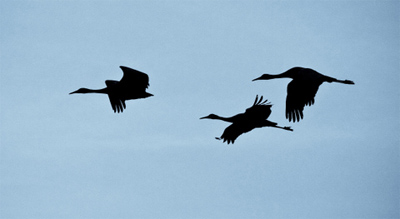 Cranes in silhouette. 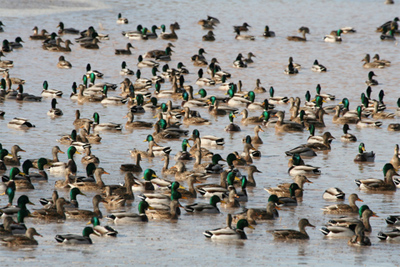 A multitude of ducks taking advantage of Bosque del Apache’s wetlands. Photos by Thomas Christie |
It wasn’t but a few minutes before the snow geese had passed and the skies were clear and calm again. Then the cranes came, flying in twos or threes they glided directly above our heads, calling to each other with voices that almost cooed. At times they were only a couple meters above us and we could make out the distinctive red patch on their foreheads. As the cranes prepared to land they extended their legs and used their wings to slow down, providing a sight both fragile and comic. As they fall toward the earth, the birds appear as though a single gust of wind would send them spinning, looking for a moment almost like some perilous hang-glider. But this was the time for soaring. For a half hour the cranes continued to fly over us and the sun warmed the park. It was a morning to remember.
Visiting:
The festival is held every year in November. You can register for the festival and specific activities on-line: friendsofthebosque.org/crane. Booking a hotel in advance is probably your best option, considering Socorro becomes pretty busy during festival week. Don’t forget to book activities in advance, too. There are excellent speakers, guided hikes, tours, and more.
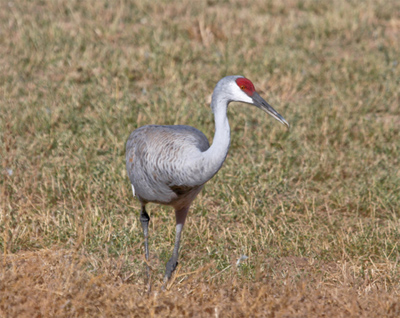 Sandhill crane foraging. 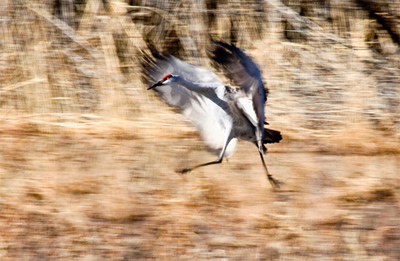 A smooth landing. 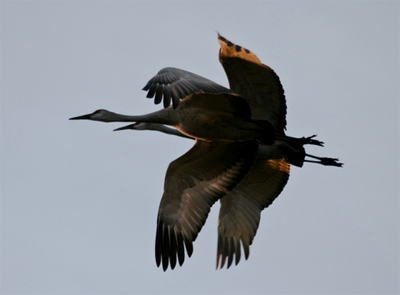 Sandhill cranes in flight. Photos by Thomas Christie |
The cranes at Bosque del Apache arrive in the fall and stay till around February. One can see them anytime, but the festival is usually held around the peak of their numbers.
Another Crane Festival is held in Monte Vista, CO in March. The cranes from Bosque del Apache stop in Monte Vista on their way north. For more information: CraneFest.com
Other fauna:
On our trip we had the good fortune of seeing two bobcats confronting each other, in addition to coots, wild turkeys, raptors, Canada geese, a variety of ducks, and of course snow geese and sandhill cranes. Other animals that frequent Bosque del Apache are red-tailed hawks, bald and golden eagles, coyote, beaver, porcupine, and mule deer.
Gear:
Bring your best camera, binoculars, and warm clothes—the desert is very cold in the early morning.